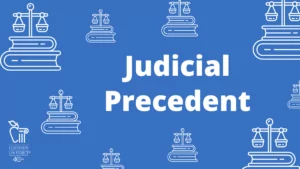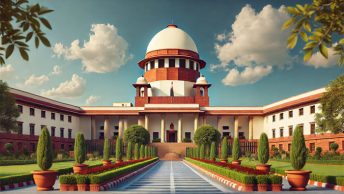Introduction
The Supreme Court recently in NBCC (India) Ltd. v. Aircon Engineering Services (“NBCC”) made a very interesting observation. It said that courts must be careful to label their judgments as to whether they are binding or not. Contrary to popular understanding, every decision of the Supreme Court is not binding under Article 141 of the Constitution. The question arises: when is a Supreme Court decision binding? In this case, the Court assumed the onus to clarify whether a decision has precedential value. This blog examines how courts navigate the line between precedent-making and decision-making, analyzes the complex role of obiter dicta, and proposes a structured test for determining the weight of judicial observations. The aim is to highlight the need for clearer judicial labeling to ensure consistency and predictability in Indian jurisprudence.
Precedent-Making v. Decision-Making
The MSMED Act, 2006 provides for expeditious dispute resolution through a Facilitation Council established under Section 18 for bypassing the conventional process before commercial courts. In NBCC, the appellant had entered into five contracts with a firm that later claimed MSME status. When disputes arose, the firm approached the Facilitation Council. The appellant contended that since the enterprise was not registered under the Act at the time of contract execution, it could not invoke Section 18 for dispute resolution. Thus, the legal question was whether an enterprise not registered prior to formation of the contract could claim benefits under Section 18 of the Act.
A similar question had been addressed in Silpi Industries v. Kerala State Road Transport Corporation (“Silpi”). Here, the appellant, an MSME, sought recovery through the Facilitation Council. The Supreme Court dealt with broader issues of the applicability of the Limitation Act and whether counterclaims under the MSMED Act were permissible, and answered both questions in the affirmative. However, the Court denied relief to the MSME on the ground that it was not registered at the time of execution of the contract, and thus held that registration under Section 8 is a prerequisite to claim the benefits of the Act. The Court said:
“In our view, to seek the benefit of provisions under MSMED Act, the seller should have registered under the provisions of the Act, as on the date of entering into the contract. By taking recourse to filing memorandum under sub-section (1) of Section 8 of the Act, subsequent to entering into contract and supply of goods and services, one cannot assume the legal status of being classified under MSMED Act, 2006, as an enterprise, to claim the benefit retrospectively . . . If any registration is obtained, same will be prospective and applies for supply of goods and services subsequent to registration but cannot operate retrospectively. Any other interpretation of the provision would lead to absurdity and confer unwarranted benefit in favour of a party not intended by legislation.”
The Supreme Court, however, in NBCC refused to recognize Silpi as a precedent because the question in the instant case never came up for consideration in Silpi. The Court in NBCC held that as an institution, the Court performs the twin functions of ‘precedent-making’ and ‘decision-making.’ It remarked that every judgment or order in disposing of appeals is not intended to be a binding precedent under Article 141 and therefore, it must differentiate between decisions intended to be precedents and those intended to dispense justice.
For a judgment to have binding effect under Article 141 of the Constitution, it must be express, founded on reason, based on conscious consideration of issues, and must not fall under the exceptions of sub silentio and per incuriam. It is also pertinent to know that what is considered precedent is only the proposition of law as laid down in the decision, i.e., the ratio decidendi.
The Curious Case of Obiter Dicta
While the ratio decidendi is the reason for a court’s decision and is part of the judgement delivered at the end of a case, obiter dicta are passing remarks and not officially part of the ruling and have no precedential value.
However, in the Indian legal system, certain cases have reiterated the binding capacity of obiter dicta of the Supreme Court over the High Courts and other subordinate courts. In Hiralal Gnaeshmal Jain v. State of Maharashtra, it was observed that even the obiter dicta of the Supreme Court will be binding on lower courts. However, if the issue being decided already has a direct decision of the Supreme Court but there also exists an obiter dicta on the same issue that is contrary to the direct decision, then the authority of the direct decision will prevail over the obiter dicta. The UK Supreme Court has also held in Bennett Ifediorah v. Ben Ume that an obiter dictum has binding effect on the lower courts.
On the other hand, the Supreme Court itself has clarified in numerous decisions that its decision must not be treated as precedent, especially in cases where it has used its powers under Article 142, considering the specific facts and circumstances.
As per judicial discipline, NBCC could not overrule a judgment of a coordinate bench so it also referred the issue to a larger bench. Interestingly, the reasoning in Silpi relied upon the ratio of Shanti Conductors Pvt. Ltd. v. Assam State Electricity Board, a three-judge bench decision, which held that the date of supply determines the applicability of protective legislation for small enterprises. Silpi therefore, adopted the reasoning of a binding precedent into its analysis under the MSMED Act. However, NBCC, while departing from Silpi, also implicitly overruled a position that was consistent with a three-judge bench ruling.
Another inconsistency is that while the Court repeatedly emphasized that Silpi’s view on registration was merely obiter and thus not binding, it nevertheless chose to refer the issue to a three-judge bench. If the Court was truly convinced that Silpi did not lay down binding precedent, why invoke the mechanism of reference at all? NBCC seems to acknowledge, albeit indirectly, that the reasoning in Silpi carried substantive weight.
The author contends that the Supreme Court did an adequate analysis of the provision in Silpi, but merely because the question of law was not formally framed, the ruling was not treated as a precedent. Had it been framed explicitly as a question of law, it would have become a precedent. Such a distinction appears arbitrary and formalistic, as it disregards the substantive depth of the court’s reasoning in favour of procedural technicalities. Such heavily reasoned obiter dicta cannot and should not be ignored, considering their binding value on lower courts.
Even though lower courts are bound by the obiter dicta of the Supreme Court, the Supreme Court itself is not bound by its own obiter, which is perhaps why it did not consider the obiter in Silpi. Obiter dicta could be a mere passing remark, personal opinion of the Judge not relevant to the case, but also a reasoned analysis of facts and the law. The distinction must be carefully drawn, but it is essential for the Supreme Court to clarify the weight of obiter dicta in its subsequent decisions and abide by its own reasoning.
The Need for a Structured Test
In order to solve this problem of varying depths of obiter dicta, the author contends that a structured test be proposed to determine when an obiter should be seriously considered. The Court may assess characteristics such as depth, reliance, and precedential intent.
Depth: The UK Supreme Court held in Mrs. Macleans v. Inlaks Ltd. that, “many obiter dicta have had the force of rationes decidendi and the weight accorded to dicta vary with quality.” Not all obiter dicta are equal. If an obiter consists of a detailed legal analysis that goes beyond casual remarks and instead engages in a thorough examination of statutory interpretation with case laws, it must be seriously considered. Courts must not disregard an obiter that duly interprets a provision or principle of law just because it was not part of the final ruling. In L. Chandra Kumar v. Union of India, the court went beyond the immediate issue to provide an exhaustive interpretation of the scope of judicial review in the Indian Constitution, relationship between Tribunals and High Courts, and the basic structure doctrine and its implications on the curtailment of powers of High Courts.
Reliance: If subsequent judgments or lower courts have relied on a particular obiter in deciding cases, then it gains weight as a persuasive authority. If courts repeatedly cite an obiter in legal arguments and reasoning, it is a testimony to the fact that the obiter has already influenced jurisprudence and cannot simply be brushed aside. Also, if the obiter aligns with a long-standing line of judicial reasoning and precedent, then it should be given weight.
Precedential Intent: If the judgment itself demonstrates an intention to establish clarity on a legal point, courts should acknowledge and engage with it. An apt example is the Vishaka guidelines, which did not constitute the ratio of the case but were propounded to fill the legislative vacuum and carried precedential intent of the court. Similarly, in State of Punjab v. Baldev Singh, the court laid down procedural safeguards under Section 50 of the NDPS Act even though the main issue was different. This observation became the guiding principle in subsequent cases like Arif Khan v. State of Uttarakhand in 2018.
Conclusion: Flagging Precedents for Clarity
The best approach would be that the Supreme Court introduces a standardised approach wherein it clearly flags which sections of its judgments indicate precedent, which sections have mere persuasive value, and which sections are general observations and must not be treated as precedent at all because they were delivered considering the peculiar facts and circumstances of the case. This is what has been emphasised in NBCC.
By the very reasoning of the Supreme Court in NBCC, the direction to differentiate between precedents and non-precedents is also not binding, as it is obiter dicta and not laid down on a conscious consideration of issues. In India, being a common law country, the refusal to regard Silpi as a precedent is a reminder that judicial consistency is a necessity. This also raises the need to have standardised tests to assess the weight of obiter dicta and clearly flagged judgments of the Supreme Court available to Judges, lawyers, jurists, students alike. In a system where the echoes of past judgments shape the future of jurisprudence, heavily reasoned obiter dicta should not be lightly discarded.
Ishita Bhardwaj is a second-year student at Rajiv Gandhi National University of Law, Punjab and is a member at Centre for Constitutional Law and Governance, RGNUL.
[Ed note: This piece was edited by Hamza Khan and published by Baibhav Mishra from the Student Editorial Team.]







İmitasyon Saatler
Rolex Saatler
Rolex Saatler
İmitasyon Saatler
Rolex Saatler
İmitasyon Saatler
İmitasyon Saatler
Rolex Saatler
Rolex Saatler
Rolex Saatler
İmitasyon Saatler
Rolex Saatler
Rolex Saatler
Your blog is a treasure trove of valuable insights and thought-provoking commentary. Your dedication to your craft is evident in every word you write. Keep up the fantastic work!
Rolex Saatler
İmitasyon Saatler
Rolex Saatler
Rolex Saatler
Rolex Saatler
Rolex Saatler
Rolex Saatler
İmitasyon Saatler
Rolex Saatler
İmitasyon Saatler
Rolex Saatler
Rolex Saatler
Rolex Saatler
Rolex Saatler
Rolex Saatler
İmitasyon Saatler
Your blog is a shining example of excellence in content creation. I’m continually impressed by the depth of your knowledge and the clarity of your writing. Thank you for all that you do.
İstanbul, Türkiye’nin ekonomik ve ticari merkezi olarak, hem bireylerin hem de şirketlerin vergi yükümlülüklerinin oldukça yoğun olduğu bir şehirdir. Vergi mevzuatındaki karmaşık düzenlemeler ve sık sık yapılan değişiklikler, mükelleflerin zaman zaman hukuki desteğe ihtiyaç duymasına yol açmaktadır. İstanbul vergi avukatları, hem gerçek hem tüzel kişilere, vergi uyuşmazlıklarında profesyonel danışmanlık ve temsil hizmeti sunarak, olası cezaların ve kayıpların önüne geçilmesine yardımcı olur.